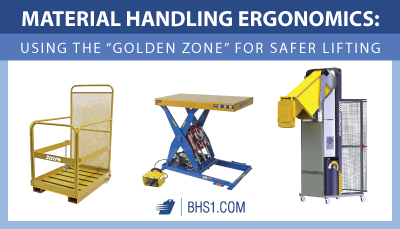We use cookies to make your experience better. To comply with the new e-Privacy directive, we need to ask for your consent to set the cookies. Learn more.
Material Handling Ergonomics: Using the Golden Zone for Safer Lifting
Warehouse managers often focus on equipment solutions to ergonomics issues. And while there's good reason to invest in assistive lifting equipment, there are cheaper and easier ways to get big returns. The number one way? Teach workers to lift in the ergonomic "golden zone."
The Dangers of Poor Lifting Technique
The Bureau of Labor Statistics (BLS) reports that in 2015, musculoskeletal disorders, such as sprains and strains caused by heavy lifting, made up 31 percent—356,910 individual cases—of all workplace injuries. The predictable and preventable nature of these injuries makes them an obvious target for managers looking to increase productivity.
Reducing the number of musculoskeletal injuries is simple in theory but requires constant attention in practice. Here are some tips for staff to keep them healthy.
-
Warm up: Stretch your back and legs before the lift.
-
Know the object's weight: If it's too heavy for one person, ask for help or use lifting equipment.
-
Make sure your pathway is clear: The duration of the lift will be shorter if you can take a direct and clear route to the destination.
-
Lift in the golden zone (also called the power zone).
-
Avoid repetitive motions: Rotate employees to give overused muscle groups a break.
-
Lift with your legs: Even when moving a load diagonally, pivot with your feet instead of twisting your back.
Managers who emphasize these straightforward tips will see a reduction in preventable injuries and enjoy productivity benefits. And remember, employers should not only teach these strategies, but periodically check to make sure they are continually being followed.

Finding the Golden Zone
The golden zone in ergonomics refers to the area nearest to the core of your body between your shoulders and knees. Even better, the Occupational Safety and Health Administration (OSHA) recommends sticking to an area between the mid-thigh and mid-chest to allow employees to lift with even more ease.
Lifting heavier items in this zone reduces stress on the back and lets employees exert less effort. That means their chances of injuries go down and their energy levels go up. That's good for morale and productivity.
Lifting Equipment Still Has a Role
Education and proper lifting technique go a long way toward reducing workplace injuries, but assistive equipment is necessary in some situations. For instance, a recycling center where workers repeatedly empty heavy trash cans will need a bin dumper or the turnover rate due to injury will be unacceptably high. Some loads are just too heavy for employees to safely carry without assistance.
The winning combination is to use assistive equipment to bring loads to the golden zone and then let employees take over. This could take the form of lift tables raising a pallet to a more comfortable height or a work platform raising an employee so he can pick an item without lifting the load above his shoulders.
Modern warehouses have more tools than ever to avoid costly injuries to staff. Pallet carousels and tilt tables make warehouse work safer and easier than ever. Just don't forget that education and knowledge of the golden zone are also part of your toolbox.
References:
Bond, Josh. "Ergonomics: Finding and maintaining the golden zone." MMH. Peerless Media LLC, 1 Feb. 2014. Web. 12 Sept. 2017.
"Ergonomics eTool: Solutions for Electrical Contractors." OSHA. Occupational Safety and Health Administration, U.S. Department of Labor, n.d. Web. 12. Sept. 2017.
"Nonfatal Occupational Injuries and Illnesses Requiring Days Away From Work, 2015." BLS. Bureau of Labor Statistics, U.S. Department of Labor, 10 Nov. 2016. PDF. 12 Sept. 2017.
"Proper Lifting Techniques." Ergo-Plus. Ergonomics Plus, Inc, n.d. PDF. 12 Sept. 2017.
